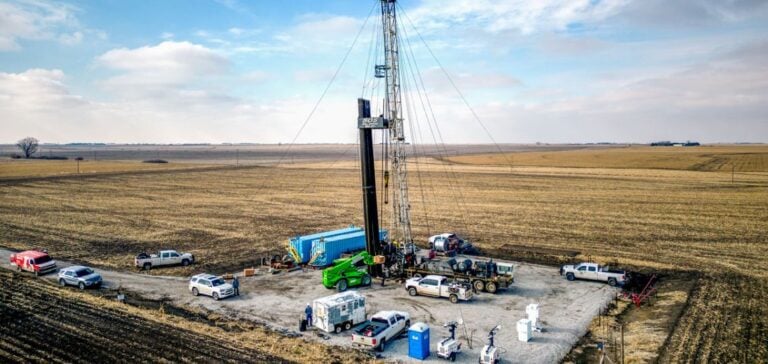Native hydrogen, often referred to as white hydrogen, has recently garnered significant attention in the energy industry. Unlike “green” or “gray” hydrogen, it results from geological processes without industrial intervention, such as electrolysis or hydrocarbon reforming. Some organizations, including the United States Geological Survey (USGS), estimate the global potential of this gas buried in the Earth’s crust to be billions of tons. Operators seeking diversification opportunities are focusing their efforts on precisely identifying deposits, with the prospect of a long-lasting supply.
Geological Resources and Capacity Estimates
Available data on native hydrogen is inconsistent. Some regions, such as oceanic ridges or ancient cratons, contain notable quantities of dihydrogen (H2) generated through the oxidation of iron-rich rocks. In these environments, water reacts with specific minerals, gradually releasing gaseous hydrogen. Current estimates, still partial, suggest that this process could continue over vast time scales, ensuring a continuous renewal.
Studies also point to the existence of shallower deposits, such as in Mali or parts of Europe. According to several surveys, hydrogen can rise along fractures and accumulate in underground reservoirs, sometimes associated with gases like helium or methane. The USGS has suggested an order of magnitude of one trillion tons of potentially recoverable hydrogen, based on cross-referencing various datasets. However, this evaluation remains hypothetical, as the geographic distribution and concentration of deposits vary considerably depending on the nature of the rocks.
Field Studies and Extraction Methods
Several companies are beginning to locate these resources using techniques derived from the oil sector. Drilling is a primary method for confirming the existence of a deposit, assessing the gas pressure and purity, and testing the economic feasibility of long-term exploitation. Hydrogen’s extreme lightness, which allows it to escape through even the smallest cracks, requires the use of enhanced sealing devices.
Research programs on this subject also focus on the chemical composition of the collected fluids. Often, native hydrogen coexists with other molecules. Separating hydrogen from other gases adds additional costs, unless the valorization of by-products like helium offsets part of the expenses. Universities and laboratories involved in these exploration efforts collaborate with industrial partners to improve the mastery of drilling, containment, and purification methods.
Potential, Costs, and Reserve Stability
Interest in native hydrogen is partly explained by its theoretically continuous supply model, which does not rely on a massive input of electricity or hydrocarbons. For several investors, it represents a complementary path to diversify the gas supply. Profitability estimates, however, depend on various factors, including the depth of reservoirs, the quality of the cap rock, and the logistical accessibility of the explored area.
Analysts highlight the difficulty of setting a standard production cost for geological hydrogen due to the unique characteristics of each basin. In some cases, volcanic rock or salt provides an almost airtight seal, allowing the accumulation of significant amounts of H2. In other areas, hydrogen disperses in the Earth’s crust, making recovery significantly more challenging. The issue of scaling storage infrastructure, either on-site or nearby, adds to the challenges of extraction.
Available Data and Market Outlook
Specialized exploration companies regularly publish technical reports documenting their findings. Some studies mention concentration ratios of up to 96% pure hydrogen in wells, potentially simplifying post-extraction processing. However, volumes must be sufficiently high to justify drilling and separation costs. Industry experts urge caution, as this emerging market depends on still-limited trials.
Several financial groups are interested in native hydrogen deposits, aiming to develop partnerships or even create new production centers. Gas industry executives stress the need to establish standards for safely handling and transporting this flammable gas. Legislative developments, such as the inclusion of native hydrogen in mining codes, encourage the advancement of pilot projects.
Operational Challenges and Scientific Collaborations
In-depth academic research is exploring the mechanisms behind natural hydrogen formation. Processes such as serpentinization, radiolysis (water splitting under radioactivity), or the decomposition of ultramafic rocks are major avenues to explain this gas’s emergence. Partnerships between laboratories and industrial actors are multiplying to characterize parameters like pressure, temperature, and water flow.
Companies involved in this white hydrogen niche are considering localized production to meet regional demands without relying on long transportation circuits. This approach could reduce emissions generated by logistics. Meanwhile, some consortiums are considering exports, packaging hydrogen in compressed or liquefied form, which requires more substantial infrastructure.
Ongoing Observations and Sectoral Adaptations
Drilling programs continue in various regions, including the United States, Australia, parts of Africa, and the Alpine arc in Europe. Initial measurements confirm the presence of hydrogen in these areas, with varying concentrations. Specialists remain attentive to the stability of the flow to determine whether production can be sustained over time.
Simultaneously, studies on the isotopic composition of dihydrogen guide the understanding of its deep or surface origin. This data, combined with analyses of fractures and faults, helps target the most promising locations. The shared goal among companies and research organizations is to reduce the economic risk of exploration.
Exploration, Industry Monitoring, and Regulatory Adjustments
Several countries have begun adapting their regulations to oversee the extraction of native hydrogen, recognizing it as a distinct gas resource. Legislative changes sometimes include environmental reporting clauses to monitor drilling and prevent potential local pollution. Traditional oil and gas entities are reviewing their portfolios, considering white hydrogen as a possible growth driver if demand strengthens.
The funding of these operations relies on a wide range of sources: major energy groups, mining companies, specialized investment funds, and even governments interested in energy diversification. Feedback from field pilots will determine the economic viability of this sector. If the results prove relevant, native hydrogen could complement existing commercialized hydrogen sources.





















